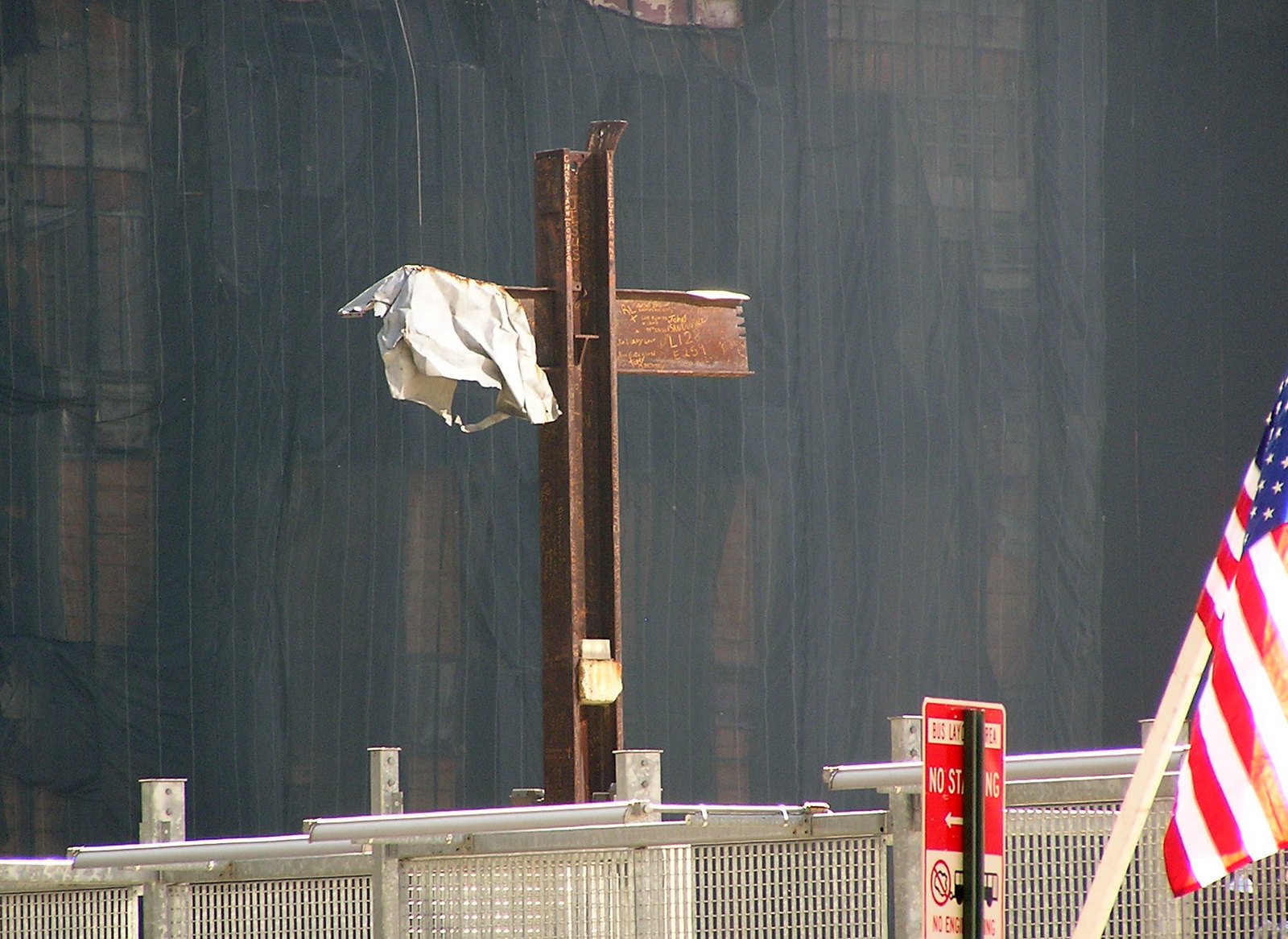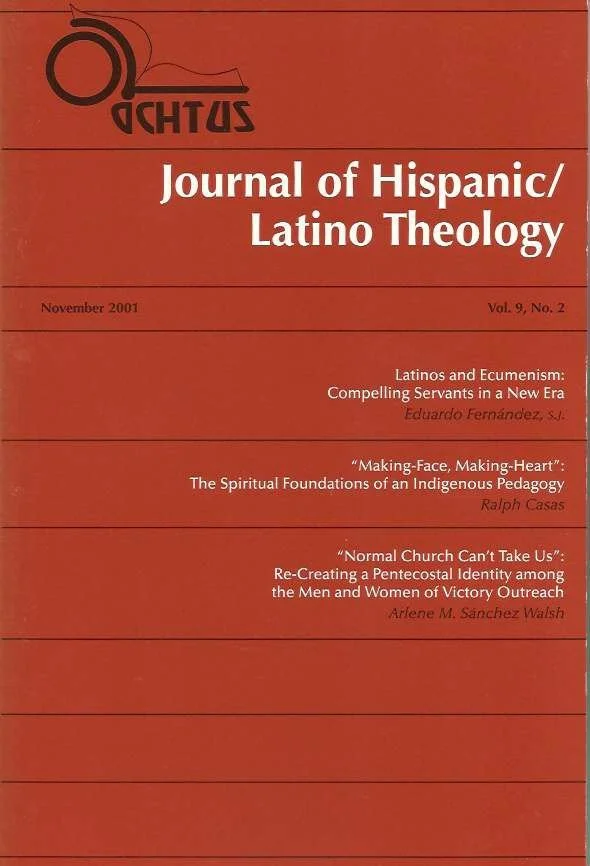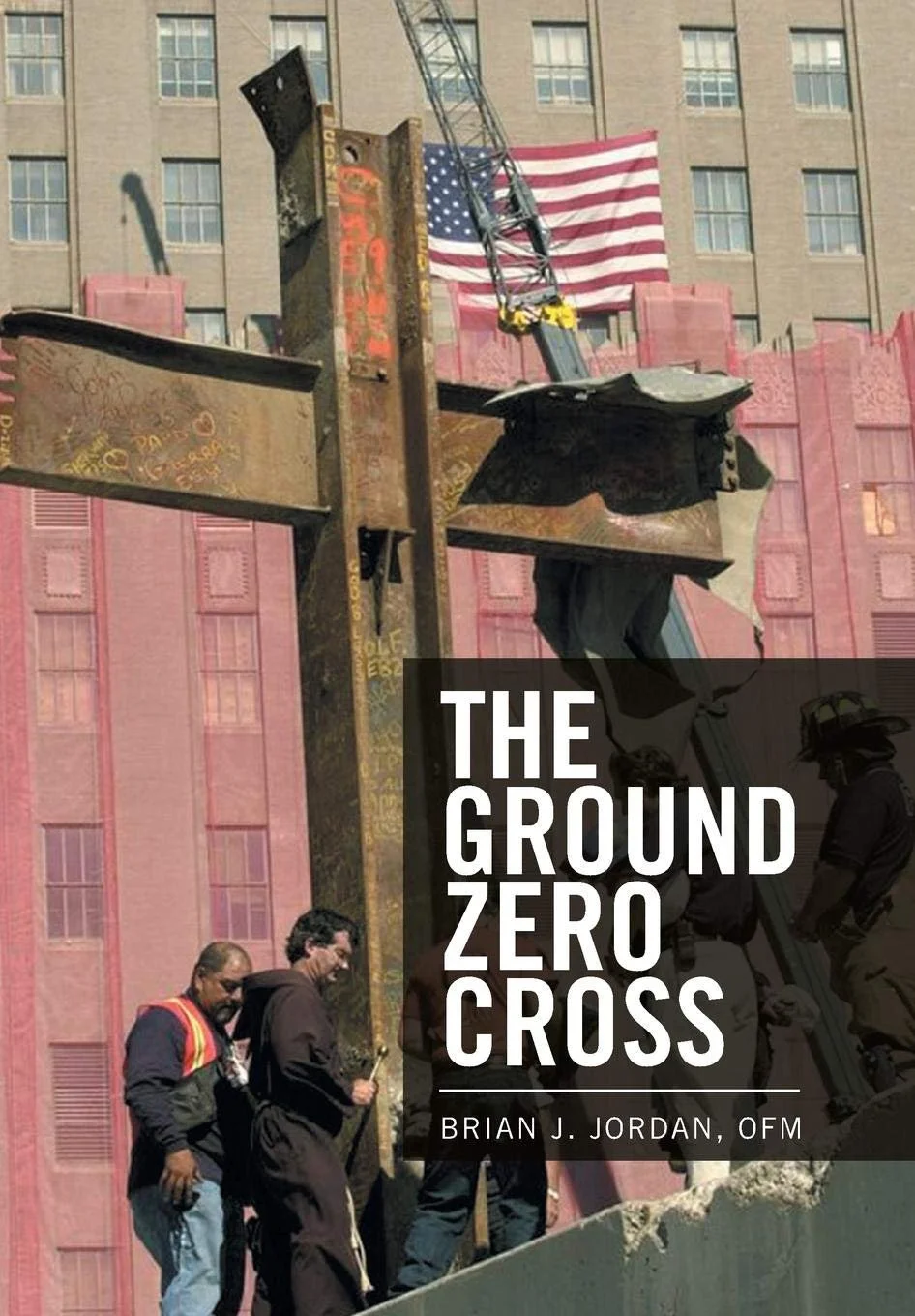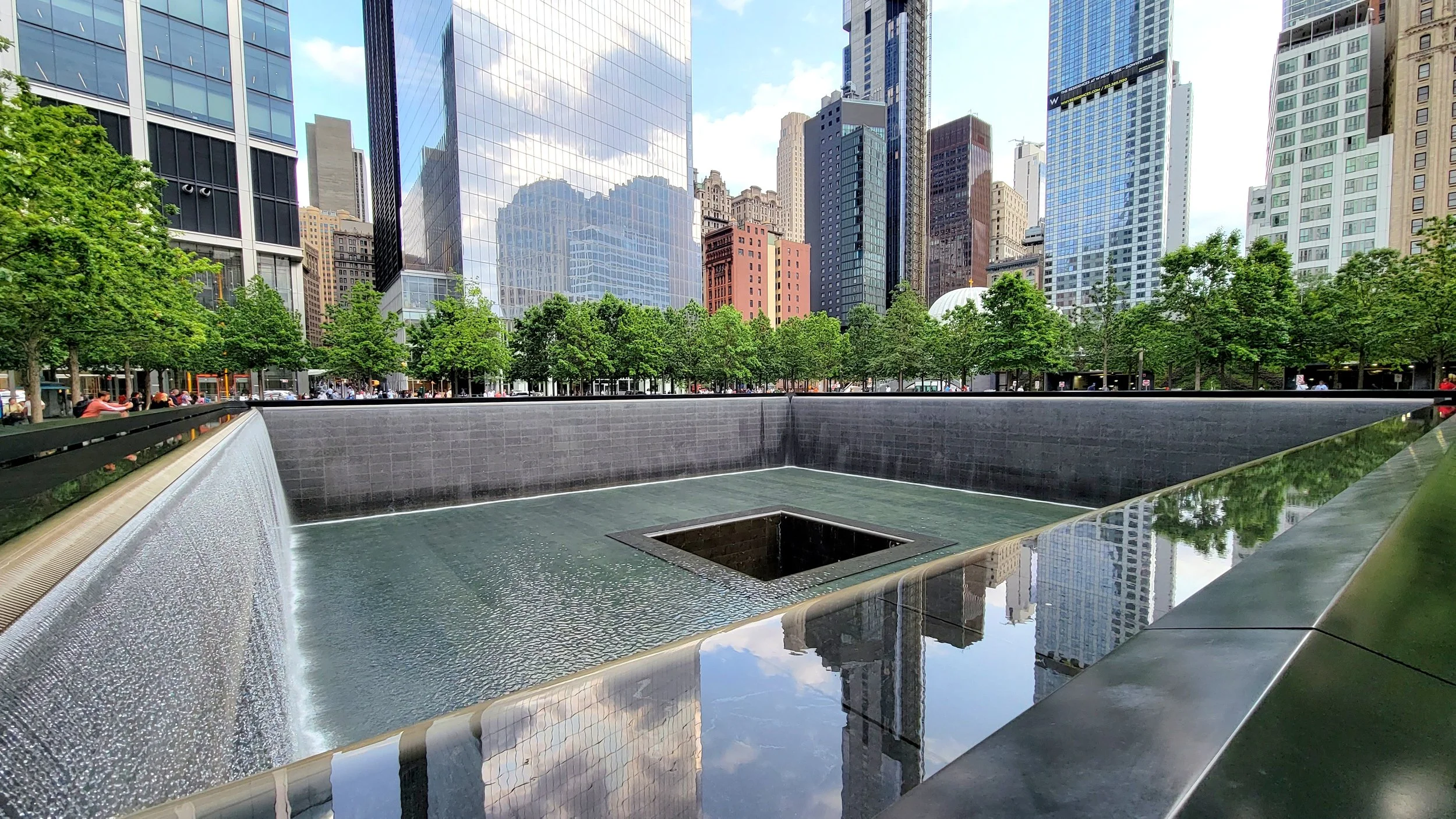9/11 at 22
A selection of resources that touch on how issues of religion, Latinidades, and social justice have been impacted by the 2001 September 11 attacks
The World Trade Center (WTC) cross, also known as the Ground Zero cross, New York City, September 2005. Following the 9/11 attacks in 2001, the two broken, cross-like, steel beams had been found by construction worker Frank Silecchia near the 6 World Trade Center debris in Lower Manhattan and was later welded together by ironworkers. The 17-foot-tall cross became an icon of hope and comfort throughout the recovery efforts. On October 4, 2001, it was blessed by Father Brian Jordan during a ceremony at nearby Zuccotti Park, where hundreds of recovery workers and their families had gathered. The Franciscan had been ministering to workers and blessing human remains recovered at the site, comforting rescue and recovery workers after the 9/11 attacks. As detailed in his memoir The Ground Zero Cross (Xlibris, 2017), Fr. Jordan spent Sunday after Sunday holding mass and offering communion at the base of the cross. The WTC cross was lowered into its permanent setting inside the September 11 Museum, which opened to the public in 2012, where it has been on exhibit since 2014. Photo: H. Michael Karshis
September 11, 2023 marks the 22nd anniversary of the September 11, 2001 terror attacks. The attacks drove home the global perception of the United States as a gold-headed statue “of extraordinary splendor”–but one with feet of iron and clay (Daniel 2:31-35). In addition to shifting geopolitics worldwide, 9/11 changed the United States in countless ways. The attacks changed the way we traveled, how we saw our neighbor to the south—Mexico—and prompted a steady rise in right-wing rhetoric that reinvigorated white nationalism. There was also a reexamination of how Islam and Muslims had been covered by the U.S. media, ushering in an era of interfaith conversation, an attempt to reconcile and understand.
HTI Open Plaza has curated a selection of 22 resources that touch on how issues of religion, Latinidades, and social justice have been impacted by 9/11.
PUBLICATIONS
“Ecumenism and Paths to Peace in a Time of Terror.” Journal of Hispanic/Latino Theology, Vol. 9, No. 2 (Nov. 2001).
Founded in 1993, the Journal of Hispanic/Latino Theology is published by The Academy of Catholic Hispanic Theologians of the United States (ACHTUS). In the November 2001 issue, editor Jean-Pierre Ruiz writes:
“The June 2001 Fourteenth Annual Colloquium and General Meeting of the Academy of Catholic Hispanic Theologians of the United States, held at the Catholic Theological Union in Chicago, took as its theme ‘New Directions in Ecumenism: Ministry and Theology’...This was by no means the first time that members of ACHTUS have focused on ecumenism. At the colloquium, ecumenism came to center stage as the focus of the teología de conjunto that characterizes the colloquium’s proceedings. In the wake of the tragic events of September 11, 2001, events too horrible for any of us to have imagined, the need for ecumenical and inter-religious understanding is more pressing than ever, and by no means only among Latina/os. The fruits of hatred and intolerance, fueled by ignorance and misunderstanding, continue to surface in deadly ways in every part of a world that daily grows smaller and more interconnected. It is our hope that the articles that appear in this issue…will contribute in some small measure to the advancement of the ecumenical and interreligious imperative.”
Articles included in the issue:
“Latinos and Ecumenism: Compelling Servants in a New Era” by Eduardo Fernández S.J.
“‘Making-Face, Making-Heart:’ The Spiritual Foundations of an Indigenous Pedagogy” by Ralph Casas
“‘Normal Church Can’t Take Us:’ Re-creating a Pentecostal Identity among the Men and Women of Victory Outreach” by Arlene M. Sánchez Walsh
“9/11’s Immigration Legacy.” Latino USA, 9 October 2021.
September 11, 2001 marked a sharp, lasting redirection in U.S. immigration policy and attitudes. This episode of Latino USA explores major changes and events from the past 20 years of immigration through the lens of this one catastrophic day.
Bender, Steven W. “Sight, Sound, and Stereotype: The War on Terrorism and Its Consequences for Latinas/os.” Oregon Law Review, Vol. 81, No. 4, p. 1153-1178 (2002).
ABSTRACT: In the days and weeks following the September 11 terrorist attacks, reports emerged of hate crimes, discrimination, and profiling directed at Arab Americans, Arabs, and Muslims in the United States. Although aware that the primary targets of the public and private response against terrorism were those of Arab or Muslim appearance, I realized that the backlash within the United States also affected Latinas/os and certain other subordinated groups. This article grew out of my concern that while Latinas/os at first might be deemed "safe" by the American public, their negative societal construction made their targeting inevitable as the fervent, amorphous war on terrorism took shape. Below, I detail perceptions of Latinas/os in society's imagination that might be relied upon to justify their inclusion in the war on terrorism. After reviewing the potential negative consequences for Latinas/os of government and private action against terrorism, I assess the opportunities for positive transformation of our societal values in the quest to define nationhood after September 11.
Branton, Regina, Erin C. Cassese, Bradford S. Jones, and Chad Westerland. “All Along the Watchtower: Acculturation Fear, Anti-Latino Affect, and Immigration.” The Journal of Politics, Vol. 73, No. 3 (July 2011).
ABSTRACT: In this article, we consider how the factors driving Anglo attitudes toward immigration changed in the post-9/11 era. We argue that in the aftermath of the 9/11 attacks, the immigration issue became nationalized, framed in a threat context. In this context, acculturation fear and anti-Latino sentiment are strong predictors of restrictionist sentiment; in the pre-9/11 period, these factors have little substantive impact on Anglo attitudes. We theorize that the current climate has helped “activate” social identities, which in turn has deleterious consequences for the Latinos in the United States. Using data from the 2000 and 2004 National Election Studies, we estimate a model of Anglo immigration attitudes. We show indicators of acculturation fear, anti-Latino sentiment, and media exposure significantly relate to Anglo immigration attitudes in the post-9/11 period but not the pre-9/11 period.
Ciro, D., Pietrzak, R. H., Lee, R. J., Rodriguez, J., Singh, R., Salim, R., Schechter, C. B., Southwick, S. M., Crane, M., Harrison, D. J., Luft, B. J., Moline, J. M., Udasin, I. G., & Feder, A. “Acculturation, coping, and PTSD in Hispanic 9/11 rescue and recovery workers.” Psychological Trauma: Theory, Research, Practice, and Policy, 13.1 (2021), 84–93.
OBJECTIVE: Research examining the responders of the World Trade Center terrorist attacks of 9/11 has found that Hispanic responders are at greater risk for posttraumatic stress disorder (PTSD) than non-Hispanic White responders. However, no studies have examined how acculturation may influence the relationship between coping and PTSD in Hispanic 9/11 responders. This novel study is the first to examine differences in coping and PTSD among Hispanic responders by level of acculturation. METHODS: The sample is composed of 845 Hispanic 9/11 responders who were seen at the World Trade Center Health Program and participated in a web-based survey. Using logistic and multiple linear regression, we examined how acculturation is related to their coping strategies and risk for PTSD. We also tested for interaction to examine whether level of acculturation moderated the relationship between coping and PTSD symptom severity. RESULTS: Key findings revealed that higher acculturation is associated with the use of substances, venting, and humor to cope, while lower acculturation is associated with the use of active coping and self-distraction in this sample. We also found that less acculturated responders were more likely to experience more severe PTSD. Lastly, our findings revealed that Hispanics who are more acculturated and used substances to cope had more severe PTSD than less acculturated responders. CONCLUSION: These findings highlight the need to consider the role of acculturation in Hispanic responders’ coping and PTSD.
Contreras, Russell. “The Latino pain of Sept. 11.” Axios Latino, 9 September 2021.
EXCERPT: “Around 250 Latinos were killed during the terrorist attacks of Sept. 11, including some undocumented immigrants from Latin America whose families faced daunting tasks to prove they even existed…[A]dvocates are working to memorialize the toll the attacks had on Latinos, whose sacrifices that day are often overlooked.”
Demeo, Marisa J. “Latinos, the WCAR and 9/11.” Poverty & Race Journal, Vol. 11, No. 1 (January/February 2002).
“The August-September 2001 United Nations World Conference Against Racism, Racial Discrimination, Xenophobia and Related Intolerance [WCAR], in Durban, South Africa, was an event of epic proportions, despite the Bush Administration’s disgraceful decision first to send a low-level delegation, then to walk out. Follow-up work by NGOs in the US (and elsewhere) was of course deeply impacted by the events of September 11 and their aftermath. We asked a number of people who attended – some PRRAC Board members (past as well as present) and other friends of PRRAC [Poverty & Race Research Action Council]– to offer their reflections on the meaning of these events for race issues and work in the US” (PRRAC).
Felbab-Brown, Vanda. “9-11 and the US-Mexico border: New challenges 20 years later.” Mexico Today, 10 September 2021.
“Leading up to the September 2021 High-Level Economic Dialogue between the United States and Mexico, Vanda Felbab-Brown reflects on how 9-11 shaped the U.S.-Mexico bilateral relationship, and what border security efforts need to be enhanced to better facilitate the safe movement of goods and people” (The Brookings Institution).
Felbab-Brown, Vanda. “The chilling of US-Mexico security collaboration.” Mexico Violence Resource Project Reimagining the Future of U.S.-Mexico Security Cooperation Roundtable series, 9 February 2021.
“The U.S.-Mexican security relationship has undergone serious deterioration over the past several months, compounding a deeper unraveling of the security cooperation during the Andrés Manuel López Obrador administration, explains Vanda Felbab-Brown. Restoring collaboration will be difficult because the evisceration of the security collaboration goes beyond an immediate crisis” (The Brookings Institution).
Hellman, Judith Adler. “Editor’s Foreword: The Meaning of September 11th for Latin America and the Caribbean.” Canadian Journal of Latin American and Caribbean Studies/Revue canadienne des études latino-américaines et caraïbes, Vol. 26, No. 52 (2001), pp. 141–50.
Jordan, OFM, Brian J. The Ground Zero Cross. Xlibris, 2017.
Two days after the terrible attack against the World Trade Center on September 11, 2001, a union construction worker made a remarkable discovery within the ruins of World Trade Center 6. He saw a cross-like beam that stood on top of a heap of debris. He was stunned by its significance as were countless others after him. The purpose of this book is to trace the thirteen-year odyssey of this iconic cross from World Trade Center 6, to its position atop a concrete abutment within the World Trade Center during the recovery and rebuilding period, to the outside wall of St. Peter’s Roman Catholic Church across from Ground Zero and finally to the National 9/11 Memorial Museum, where it remains today. The odyssey also includes a three-year legal battle, whose appellate decision found that the Constitution of the United States does not preclude the presence of the Ground Zero cross within the National 9/11 Memorial Museum. This book is the author’s personal memoir. He is a Franciscan priest who, through many uncertain days, was the unofficial guardian of the Ground Zero cross. The concurrent themes of the book treat spirituality, grief sharing, selfless sacrifice, architecture, church history, biblical theology, and litigation. The book tells the story of many obstacles transcended on the way to the triumph of the Ground Zero cross.
Londono, Stephanie. "Immigrant Latinas and their Shahadah in Miami." Commissioned Reports, Papers and Presentations, Kimberly Green Latin American and Caribbean Center, Florida International University (FIU), pp. 1-38.
“This commissioned paper delivered as part of LACC's Islam in Latin America project focuses on immigration, gender and religion and Latino Muslims. Londono pays particular attention to pre-conversion religious participation, Latinas' motives for conversion, how experiences of oppression influence Latinas' decisions to convert to Islam, and adjustments made by Latina Muslims in Miami. She provides an astute examination of the nuances related to Latina conversion to Islam, how their new religious membership encourages or obstructs their civic engagement and assimilation, and how their experiences as immigrants inform their conversion to a ‘foreign religion’” (FIU).
Lopez Garcia, A. I. “The Myth of 9/11 in Latin America.” Cornell International Affairs Review, 2(1), 35–40.
ABSTRACT: It is often argued that the first and most visible impact of the terrorist attacks of 9/11 has been the reordering of Washington’s priorities in its relations with Latin America. The United States (U.S.) has focused its attention outside the hemisphere and placed Latin America at the “bottom of U.S. terrorist agenda”...The effects of U.S. foreign policy towards Latin America after 9/11 have not repeated the pattern of the Cold War. Although Latin America no longer is the overriding priority of American foreign policy, the U.S. has not neglected the region, nor, as many analysts have argued…has it become disengaged from the hemisphere. The terrorist attacks did not introduce a different agenda for U.S.-Latin American relations from that of the post-Cold-War period. Free trade, illegal migration and the fight against drugs have continued to be the main issues of U.S.-Latin American relations. Even the trend towards militarization of U.S. foreign policy began in Latin America long before the terrorist attacks. U.S.-Latin America relations have been affected significantly not by the consequences of 9/11, but rather by the negative effects of the U.S-promoted economic model in the region. The failures of the so-called Washington Consensus are not linked to the terrorist attacks.
Loretta, Jim. “Qualitatively Speaking: The effects of 9/11 on Hispanic research.” Quirk’s Media, 1 April 2002.
ABSTRACT: The terrorist attacks on September 11 were seen and felt by all segments of the American society, including the Hispanic community. This article discusses the effects of September 11 on Hispanic research and offers suggestions in increasing respondent cooperation in focus groups that have helped many who work in the Hispanic research market.
Morales, Harold D. “The 9/11 Factor: Latino Muslims in The News.” Latino and Muslim in America: Race, Religion, and the Making of a New Minority, AAR Religion, Culture, and History (Oxford Academic, 2018).
ABSTRACT: In contrast to self-produced media like reversion stories, chapter 4 documents and assesses journalistic representations of Latino Muslims. In a post-9/11 media context, Latino Muslims received increased attention from journalists. It argues that these news stories have, however, reductively focused on “conversion” at the expense of more complex and diverse representations. Although much of this coverage has been reductive, it has generally not been overtly negative. An exception to this pattern is Spanish language news media, which has represented Latino Muslims in negative ways that echo the form but not the function of broader sets of orientalist images. Latino Muslims have responded by calling for boycotts and writing petitions to end the defamation of their identity group. The chapter argues that some of their responses are more reasonable than others and that they will require much broader support if these are to make any positive contributions to public discourse.
Moran, Matthew. “Rummaging Through the Ashes: 9/11 American Poetry and the Transcultural Counterwitness.” European Journal of American Studies 15:2 (Summer 2020).
ABSTRACT: By drawing on current definitions of testimonial witnessing, this study returns to the attacks of September 11th to explore how two 9/11 poems, “First Writing Since (Poem on Crisis of Terror)” by Suheir Hammad and “Alabanza: In Praise of the Local 100” by Martin Espada, challenge the pervasive patriotism of mainstream journalism through acts of transcultural counterwitnessing. I explore how these 9/11 poems oppose, and engage with, pervasive patriotism, and emphasize the value of transcultural poetry in the face of extreme violence. The notion of the transcultural counterwitness has the potential to redefine how third-party witnesses, like poets, provide new understandings of historical responsibility and national identity in the American imagination.
Hammad, Suheir. “First Writing Since (Poem on Crisis of Terror).” In Motion Magazine, 7 November 2001.
“First Writing Since” was the first poem written after September 11, 2001 by poet Suheir Hammad, who was born in Amman, Jordan, and raised in a predominately Latino and African-American community in Brooklyn, New York. Hammad writes: “my baby brother is a man now, and on alert, and praying five times a day that the orders he will take in a few days time are righteous and will not weigh his soul down from the afterlife he deserves.” After hip-hop entrepreneur Russell Simmons came across “First Writing Since,” he signed her to a deal with HBO's Def Poetry Jam. Hammad is the author of Born Palestinian, Born Black (Harlem River Press, 1996) and other works. “The creating energy is what makes us all divine,” she told Al Jadid, “not equal to God but part of God…I want to deal with God... I want everyone to deal with God.”
Espada, Martín. “Alabanza: In Praise of Local 100.” The Nation, 23 September 23, 2002.
“Martin Espada was ‘haunted’ by an investigative report from the BBC about the undocumented workers who died while working at the Windows of the World restaurant at the World Trade Center…[For Espada] ‘Alabanza’ was a tribute to the ‘shadow army making those buildings run’ who were ‘invisible in life and even more invisible in death’...Published approximately a year after the attacks…the poem is a lyrical elegy, consisting of five stanzas, rich in image and varied in tempo. Espada’s title (the Spanish word for ‘praise’) takes the closing lines of Juan Antonio Corretjer’s “Oubao-Moin” [“Island of Blood”], from his collection Alabanza en la Torre de Ciales [Song of Praise from the Tower of Ciales]...For Espada, Corretjer’s poem ‘envisioned a movement for a ‘liberated homeland’ that was not only working class, but multiracial, based on a shared history of labor and exploitation’...His use of allusion places the migrant workers at the center of a decisive moment in modern history to present the realities of American economic and political practices (Matthew Moran).
Shahmoradi, Maryam and Hasan Hosseini. "Latina Shi͑a Women in the United States of America: Converging Identities in the Twenty-First Century." Journal of Shi'a Islamic Studies, Vol. 8, No. 1 (Winter 2015), p. 19-35.
ABSTRACT: Conversion to Islam among Latinas/os in the United States has been gaining increased media and academic attention. This study explores the experiences of a doubly understudied group of converts in the United States: Latinas who convert to Shi͑ism. It looks at their pre-conversion, conversion, and post-conversion experiences to explore what unique aspects of conversion to Shi͑ism are shared among these Latinas. It also looks at how their gender affected their conversion. Special attention is given to the negotiation of multiple minority identities and how they synthesised a Latina-Muslim-American identity.
Uecker, Jeremy E. “Religious And Spiritual Responses To 9/11: Evidence from the Add Health Study.” Sociological Spectrum 28:5 (2008), 477-509.
ABSTRACT: Despite a great deal of public discourse concerning the effect of the September 11th attacks on Americans' religious and spiritual lives, social scientists know very little about the nature, size, and duration of this effect. Using panel data from the National Longitudinal Study of Adolescent Health, this study analyzes the influence of 9/11 on the religious and spiritual lives of American young adults. The results suggest that the 9/11 attacks exerted only modest and short-lived effects on various aspects of young adults' religiosity and spirituality, and these effects were variable across different groups. These findings suggest that no remarkable religious revival occurred among young adults after September 11th, and researchers interested in analyzing religious development across the life course or religious change over time need not worry about sea changes in religiosity and spirituality brought on by 9/11.
“Hispanic Heritage Month: Sgt. 1st Class Luis Quiñones” (2000-2002), U.S. Army graphic illustration by Sgt. ShaTyra Reed, 16th Combat Aviation Brigade. Source: Defense Visual Information Distribution Service
“Sgt. 1st Class Luis Quiñones, a cyber network defender assigned to the Headquarters and Headquarters Company, 16th Combat Aviation Brigade, joined the Army 18 years ago following the terrorist attacks on September 11, 2001. Quiñones worked in Times Square and watched as United Airlines Flight 175 crashed into the South Tower of the World Trade Center at 9:03 a.m. In an effort to honor his friend's father who died responding to the attacks and do something meaningful for his country, Quiñones enlisted in the Army” (DVIDS).
INSTITUTIONAL PROJECTS
Interfaith Infrastructure
The Pluralism Project, Harvard University
Interfaith Infrastructure is “a survey of the interfaith encounter in the U.S. through portraits of interfaith organizations and essays highlighting the historical and contemporary challenges of religious diversity…The events of 9/11 demonstrated the importance of interfaith groups; since then, we have witnessed the growth of hundreds of new interfaith initiatives. The ‘interfaith infrastructure’ is emerging in real-time, providing an innovative context for the kind of engagement we describe as ‘pluralism.’”
View of the 9/11 Memorial south pool, New York, NY, 2023. Designed by architect Michael Arad and landscape architect Peter Walker, the 9/11 Memorial features twin waterfall pools surrounded by bronze parapets that list the names of the victims of the World Trade Center attacks. The South Pool plaques include the names of first responders as well as victims who were killed at the South Tower, on hijacked Flight 175, at the Pentagon, on hijacked Flight 77, and on hijacked Flight 93. Photo: Nadia Eimandoust
The National September 11 Memorial & Museum
Opened to the public in 2012, the National September 11 Memorial & Museum is located at the World Trade Center site, the former location of the Twin Towers that were destroyed during the September 11 attacks. The 9/11 museum is operated by a non-profit institution whose mission is to raise funds for, program, and operate the memorial and museum at the World Trade Center site. Through commemoration, exhibitions, and educational programs, the National September 11 Memorial & Museum remembers and honors the 2,983 people killed in the horrific attacks of September 11, 2001 and February 26, 1993, as well as those who risked their lives to save others and all who demonstrated extraordinary compassion in the aftermath of the attacks.
New York City Latino 9-11 Collecting Initiative
In 2018, with funding from the Smithsonian Latino Center, the National Museum of American History launched the New York City Latino 9-11 Collecting Initiative to expand the narratives of the National September 11 Collection, identifying Latina/o/x stories, objects, and archival materials to create content and visibility for the community.





